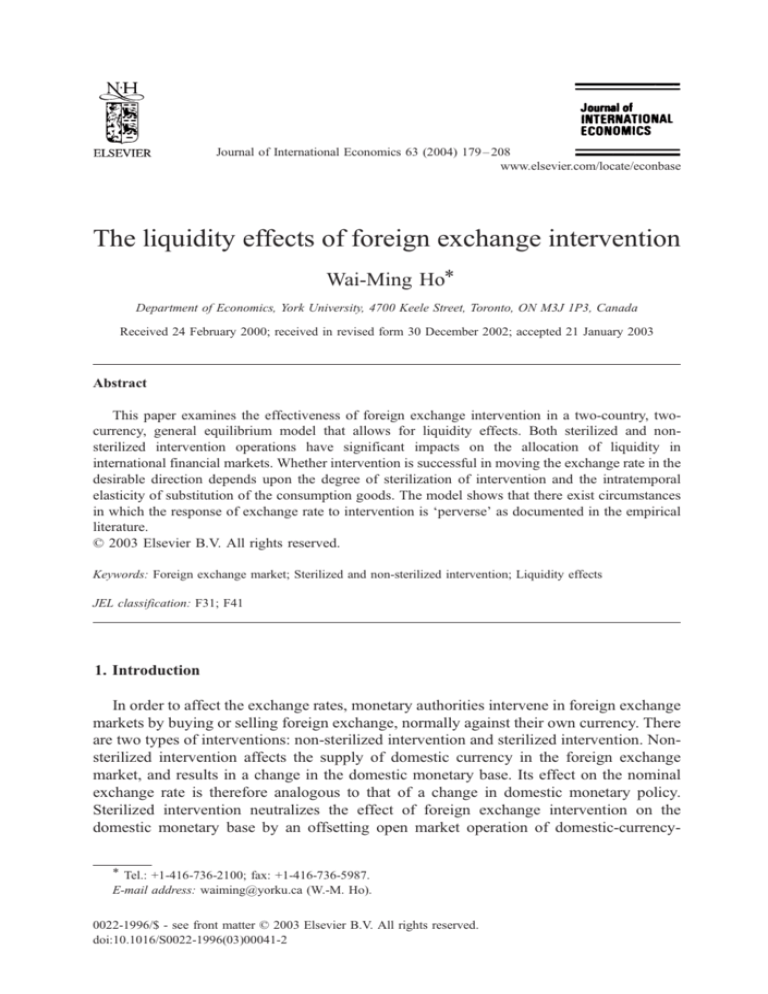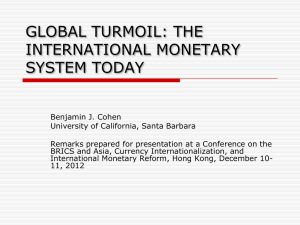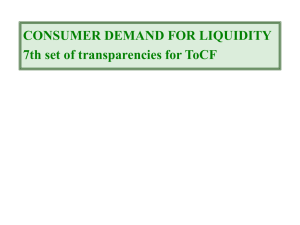
Journal of International Economics 63 (2004) 179 – 208
www.elsevier.com/locate/econbase
The liquidity effects of foreign exchange intervention
Wai-Ming Ho*
Department of Economics, York University, 4700 Keele Street, Toronto, ON M3J 1P3, Canada
Received 24 February 2000; received in revised form 30 December 2002; accepted 21 January 2003
Abstract
This paper examines the effectiveness of foreign exchange intervention in a two-country, twocurrency, general equilibrium model that allows for liquidity effects. Both sterilized and nonsterilized intervention operations have significant impacts on the allocation of liquidity in
international financial markets. Whether intervention is successful in moving the exchange rate in the
desirable direction depends upon the degree of sterilization of intervention and the intratemporal
elasticity of substitution of the consumption goods. The model shows that there exist circumstances
in which the response of exchange rate to intervention is ‘perverse’ as documented in the empirical
literature.
D 2003 Elsevier B.V. All rights reserved.
Keywords: Foreign exchange market; Sterilized and non-sterilized intervention; Liquidity effects
JEL classification: F31; F41
1. Introduction
In order to affect the exchange rates, monetary authorities intervene in foreign exchange
markets by buying or selling foreign exchange, normally against their own currency. There
are two types of interventions: non-sterilized intervention and sterilized intervention. Nonsterilized intervention affects the supply of domestic currency in the foreign exchange
market, and results in a change in the domestic monetary base. Its effect on the nominal
exchange rate is therefore analogous to that of a change in domestic monetary policy.
Sterilized intervention neutralizes the effect of foreign exchange intervention on the
domestic monetary base by an offsetting open market operation of domestic-currency* Tel.: +1-416-736-2100; fax: +1-416-736-5987.
E-mail address: waiming@yorku.ca (W.-M. Ho).
0022-1996/$ - see front matter D 2003 Elsevier B.V. All rights reserved.
doi:10.1016/S0022-1996(03)00041-2
180
W.-M. Ho / Journal of International Economics 63 (2004) 179–208
denominated bonds, and causes only a ‘pure’ change in the currency denomination of
assets held by the public. Hence, sterilized intervention is independent of monetary policy,
and if it is an effective instrument for exchange rate management, monetary authorities can
maintain greater flexibility of their monetary policy. Because of this reason, there has been
a large research effort on the effectiveness of sterilized intervention in theory and practice.
In the literature, sterilized intervention has been viewed as having effects on exchange
rates through either of two channels: the portfolio-balance channel and the signaling
channel.1 However, the evidence on the effectiveness of intervention via the two channels
is inconclusive. Given the data showing that interventions in the markets for major
currencies have been substantial and frequent in recent years, there is a clear need to
provide a satisfactory explanation of why central banks engage in foreign exchange
interventions to such a large extent.
As both sterilized and non-sterilized intervention operations result in changes in asset
supplies, such changes can have significant impact on liquidity in international financial
markets. When economic agents are subject to liquidity constraints, liquidity effects
induced by official intervention should be taken into account. The analyses of the
effectiveness of intervention via the portfolio-balance channel and the signaling channel
have ignored the crucial function of international financial markets in allocating liquidity
across market participants. Hence, it will be beneficial to investigate theoretically the
impacts of intervention within the context of a two-country, two-currency, general
equilibrium model that allows for liquidity effects.
Recent work on liquidity effects of monetary policy shocks in closed economy settings
by Bernanke and Blinder (1992), Christiano and Eichenbaum (1995), and Strongin (1995)
have provided strong empirical support for liquidity effects.2 Eichenbaum and Evans
(1995), and Grilli and Roubini (1995) extend this line of research to open-economy
settings and find that expansionary shocks to US monetary policy are followed by sharp
declines in US interest rates and sharp depreciations in US nominal and real exchange
rates.3 These findings are consistent with the predictions of the open-economy models
allowing for liquidity effects studied by Grilli and Roubini (1992), Ho (1993), and
Schlagenhauf and Wrase (1995a,b). By following Lucas (1990)’s approach to modeling an
asymmetry of monetary injections, these theoretical models examine the liquidity effects
of monetary shocks on the world economy.4 As economic agents are affected by the
1
See Edison (1993) and Dominguez and Frankel (1993) for detailed surveys of the empirical research on the
effectiveness of intervention via the two channels documented in the earlier literature, and see Sarno and Taylor
(2001) for a survey of the more recent literature on official intervention.
2
These papers find that positive shocks to money lead to reductions in the short-term nominal interest rates
and increases in output in the United States.
3
Grilli and Roubini (1995) examined data of the G-7 countries and found that while US interest rates rise
and the US dollar appreciates significantly on impact following a positive interest rate shock in the US, such
shocks in the non-US G-7 countries are often associated with an impact depreciation of their currency value
relative to the US dollar. However, they showed that after controlling for US monetary policies and expected
inflation, the response of exchange rates to positive interest rate shocks was a persistent currency appreciation in
most of the G-7 countries.
4
Fuerst (1992) is the first paper to introduce production into Lucas (1990)’s closed-economy model.









